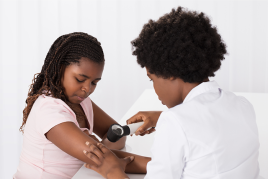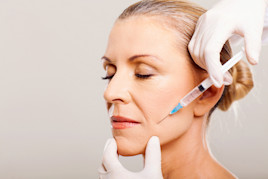Hives: Diagnosis and treatment
Hives can require emergency care
Go to urgent care or the nearest emergency room if you have any of the following:
Swelling on your face, inside your mouth, or in your throat
Problems swallowing or breathing
Feel light-headed or faint
Racing heart
Swelling on your face or inside your mouth or throat can cause problems breathing or swallowing, which can come up quickly.
For many people, hives are mild. If you have a mild case, it will likely go away in a few days. To get relief until then, dermatologists recommend that you take an antihistamine (non-drowsy, 24-hour relief) and use these home remedies.
When to see a dermatologist
It can be helpful to see a board-certified dermatologist if hives:
Last longer than 6 weeks
Cover a large area of your body
Are caused by an allergy
How do dermatologists diagnose hives?
A dermatologist can often diagnose hives by looking at your skin.
While your dermatologist may diagnose you during your first office visit, finding the exact cause of hives can take time.
You can help your dermatologist by taking time to answer these questions before your appointment:
How often do you get hives?
How long do the hives last?
Are the hives itchy or painful?
When you get hives, do you have other symptoms like feeling lightheaded or nauseous?
It can also be helpful to think about what you were doing a few hours before you developed hives. For example, try to remember what you were doing and answer the following questions?
What did you eat and drink?
Did you take a medication, including one that you can buy without a prescription, such as ibuprofen?
Have you been feeling stressed?
Did a bug bite or sting you?
Were you outdoors in sunlight, cold, or heat?
Did you sweat a lot?
Were you wearing tight clothes or carrying a purse or backpack?
Tell your dermatologist if you develop hives hours after eating red meat (e.g., beef, pork, veal, or lamb), gelatin, or dairy products
Hives can be a sign of alpha-gal syndrome, a rare food allergy that can develop after being bitten by the Lone Star tick. This tick is found in many U.S. states.

During your appointment, your dermatologist will also ask about your medical history. Be sure to mention any recent medical treatments, including radiation therapy or a blood transfusion.
Your dermatologist may also require one or more of the following medical tests:
Allergy tests (on the skin or blood test)
Blood work (to rule out an illness or infection)
To perform a skin biopsy, your dermatologist removes a small bit of affected skin so that it can be examined under a microscope.
While having answers to these questions and test results is helpful, it’s important to know that the cause of hives cannot always be found. Without knowing the cause, your dermatologist can successfully treat hives.
How do dermatologists treat hives?
When treating hives, the goals are to:
Control the itch
Prevent new hives (existing hives go away on their own)
Avoid what’s causing the hives (when known)
Your treatment plan will be tailored to your needs and may include one or more of the following:
Soothing anti-itch lotion or cream
To temporarily relieve the itch, your dermatologist may recommend prax lotion (also called pramoxine), an anti-itch cream containing menthol, calamine lotion, or another anti-itch topical (applied to the skin) that you can buy without a prescription.
Antihistamine
This medication can help control the itch and swelling. Some antihistamines may also flatten hives, shorten how long you have hives, or reduce the number of hives you get.
Your dermatologist may recommend an antihistamine that you can buy without a prescription. Some patients need a stronger antihistamine and receive a prescription.
Antihistamines that you buy without a prescription tend to work right away. With prescription antihistamines, you tend to feel the effect within 1 to 3 hours of taking the medication, and it may take 8 to 10 hours to feel the full effect, which will last about 24 hours.
The prescription antihistamines used to treat hives are desloratadine, loratadine, and hydroxyzine.
The U.S. Food and Drug Administration (FDA) has approved an antihistamine called desloratadine to treat a type of hives called chronic spontaneous hives. This antihistamine can relieve itch, reduce the number of hives, and decrease the size of hives. It’s FDA-approved to treat patients 6 months of age and older.
Loratadine is FDA-approved to treat itchiness and skin discoloration. Hydroxyzine can relieve the itch.
If the first antihistamine you take fails to work, your dermatologist may increase the dose or add another antihistamine to your treatment plan.
For an antihistamine to be effective, you must take it every day — and continue to take it every day until you’re no longer getting hives. At that time, your dermatologist will talk with you about reducing your dose until you stop for good.
Possible side effects of the antihistamines that treat hives include headache, cough, and sore throat.
Brand names (prescription antihistamines): Desloratadine (Clarinex), loratadine (Claritin), hydroxyzine (Vistaril)
How dermatologists treat a child with hives
If your child’s hives last for 6 weeks or longer, treatment often begins with trying to find the cause. Many times, the cause cannot be found. If this happens, your dermatologists may prescribe an antihistamine for your child.

Corticosteroid
When applied to the hives rash, this medication can help relieve the itch.
An oral (taken by mouth) corticosteroid may be prescribed short term if you have swelling in your throat, on your face, or hives on most of your body. It’s essential to take this medication as directed. Once you have some relief, your dermatologist will switch you to another medication.
Light therapy
When an antihistamine alone fails to clear hives, this treatment may be an option.
Also called phototherapy, this non-invasive treatment exposes your skin to a controlled amount of light. Many patients continue to take one or more antihistamines while receiving phototherapy.
To get phototherapy, you’ll need to go to a place that offers this therapy, such as your dermatologist’s office or a phototherapy treatment center. For this treatment to be effective, you’ll go to phototherapy a few (and possibly several) times a week for a few months.
Research suggests that patients who treat hives with both phototherapy and an antihistamine may stop getting hives for a longer amount of time than if they had only one type of treatment.
Possible side effects of phototherapy include sunburn like discoloration that lasts about a day. When used for years, phototherapy can cause early skin aging and increase your risk of developing skin cancer.
Omalizumab
When antihistamines fail to work, your dermatologist may prescribe this medication. It works throughout the body to calm your immune system, which can prevent your body from overreacting and producing hives.
Some people take omalizumab (oh-ma-liz-you-mab) alone. Others take it along with an antihistamine.
The FDA has approved omalizumab to treat a type of hives called chronic spontaneous urticaria in people 12 years of age and older who continue to get hives after taking antihistamines.
In clinical trials, omalizumab reduced the itch and number of hives. It can take time to work. Some people treat their hives for 4 to 6 months before they see their skin clear. While it can be an effective treatment for many people, omalizumab doesn’t work for everyone.
If your dermatologist prescribes omalizumab, you will inject it just under your skin. Before injecting yourself at home, you’ll be taught how to prepare and inject this medication.
When taken to treat hives, the most common side effects are feeling sick to your stomach, getting a cold, sinus and respiratory infections, joint pain or soreness, headache, and cough.
Brand name: Xolair
Auto-injector pen (epinephrine)
If you have hives and develop severe swelling, you may need to carry an auto-injector pen so that you can inject yourself if severe swelling occurs. An auto-injector is filled with a single dose of medication called epinephrine (aka adrenaline).
Do your lips, tongue, or throat swell when you get hives? Do you have shortness of breath?
If you answered yes to either, you may need to always carry an auto-injector pen with you.
While an auto-injector can be lifesaving, some people develop side effects. It’s important to understand that not everyone experiences side effects, which include problems seeing, confusion, and dizziness.
If you have any side effects after using an auto-injector, get immediate medical care.
Brand names: Adrenaclick, Auvi-Q, EpiPen
Other medications that work throughout the body
Antihistamines and omalizumab (both described above) are medications that work throughout the body. If these fail to work or are not right for you, your dermatologist may prescribe one of the following or another medication:
Dupilumab: This medication can reduce the itch and severity of hives. It may be an option If hives remain after treatment with antihistamines.
Like omalizumab, described above, you take this medication by injecting it under the skin. Before injecting yourself at home, you’ll be taught how to prepare and inject it.
Possible side effects include getting a cold or developing a skin reaction where you inject.
Brand name: Dupixent
Doxepin: If antihistamines fail to control hives, this may be an alternative treatment. Doxepin is an antidepressant medication that has strong antihistamine properties. It can be helpful for treating adults who have long-lasting hives. Doxepin is also a sedative, so it can help you sleep if the hives keep you awake.
Possible side effects include drowsiness, dry mouth, dry eyes, and blurred vision.
Brand names: Silenor, Sinequan
Cyclosporine: This medication can calm the immune system. By doing this, it can prevent new hives. Existing hives clear on their own.
Because of possible side effects, dermatologists carefully select each patient. Before a dermatologist prescribes cyclosporine, each patient needs medical tests. If this medication is prescribed, your dermatologist will monitor you carefully while you take cyclosporine.
Possible side effects include developing high blood pressure or worsening of high blood pressure, even when it’s controlled with medication.
Desensitization
If your hives are caused by something physical like cold, heat, or pressure on your skin, your dermatologist may recommend this treatment. It involves exposing you to what is causing your hives, so that you no longer have flare-ups every time you encounter the cause.
This type of treatment requires a lot of your time. Once you’re no longer getting hives, you must continue to expose yourself to what’s caused the hives. You’ll need to do this every day. Many people find this time commitment too much and prefer to avoid the cause.
Before you try this treatment, it’s important to know that there is no guarantee it will stop you from getting hives. Desensitization doesn’t work for everyone. When it works, it lasts but a short time without continued exposure.
At-home care can help improve results from treatment
A treatment plan often works best when you follow these dermatologists’ at-home tips. To see what dermatologists recommend, go to Hives: How to get relief at home.
Images
Image 1: Getty Images
Image 2: Produced with permission from ©DermNet www.dermnetnz.org 2024.
References
Antia C, Baquerizo K, et al. “Urticaria: A comprehensive review: Epidemiology, diagnosis, and work-up.” J Am Acad Dermatol. 2018;79(4):599-614.
Antia C, Baquerizo K, et al. “Urticaria: A comprehensive review: Treatment of chronic urticaria, special populations, and disease outcomes.” J Am Acad Dermatol. 2018;79(4):617-33.
Grattan CEH, Saini SS. “Urticaria and angioedema.” In: Bolognia JL, et al. Dermatology. (4th edition). Elsevier, China, 2018:304-19.
Hide M, Takahagi S, et al. “Urticaria and angioedema.” In: Kang S, et al. Fitzpatrick’s Dermatology. (9th edition) McGraw Hill Education, United States of America, 2019:684-785.
LaCava AF, Fadugba OO. “Cyclosporine for omalizumab-refractory chronic urticaria: A report of five cases.” Allergy Asthma Clin Immunol. 2023 Aug 29;19(1):78.
Maurer M, Casale TB, et al. “Dupilumab in patients with chronic spontaneous urticaria (LIBERTY-CSU CUPID): Two randomized, double-blind, placebo-controlled, phase 3 trials.” J Allergy Clin Immunol. 2024 Feb 29:S0091-6749(24)00196-9.
Package inserts: Desloratadine and loratadine. Last accessed 4.30.2024.
Ray SE, Boudewyns V, et al. “Generic substitution of epinephrine autoinjectors: Patient and caregiver perceptions and attitudes.” J Allergy Clin Immunol Glob. 2023 Sep 14;3(1):100170.
Saini SS, Kaplan AP. “Chronic spontaneous urticaria: The devil's itch.” J Allergy Clin Immunol Pract. 2018 Jul-Aug;6(4):1097-1106.
Sheikh G, Latif I, et al. “Role of adjuvant narrow band ultraviolet B phototherapy in the treatment of chronic urticaria.” Indian J Dermatol. 2019 May-Jun;64(3):250.
Wong HK. “Urticaria.” In: Medscape (Elston DM., Ed.) Last updated 9/16/2020. Last accessed 4/15/2024.
Written by:
Paula Ludmann, MS
Reviewed by:
DiAnne Davis, MD, FAAD
Elisa Gallo, MD, FAAD
William Warren Kwan, MD, FAAD
Shari Lipner, MD, PhD, FAAD
Last updated: 5/30/24
 Molluscum contagiosum: How to safely treat it
Molluscum contagiosum: How to safely treat it
 Biosimilars: 14 FAQs
Biosimilars: 14 FAQs
 Practice Safe Sun
Practice Safe Sun
 Relieve uncontrollably itchy skin
Relieve uncontrollably itchy skin
 Fade dark spots
Fade dark spots
 Untreatable razor bumps or acne?
Untreatable razor bumps or acne?
 Laser hair removal
Laser hair removal
 Scar treatment
Scar treatment
 Botox
Botox
 Free materials to help raise skin cancer awareness
Free materials to help raise skin cancer awareness
 Dermatologist-approved lesson plans, activities you can use
Dermatologist-approved lesson plans, activities you can use
 Find a Dermatologist
Find a Dermatologist
 What is a dermatologist?
What is a dermatologist?